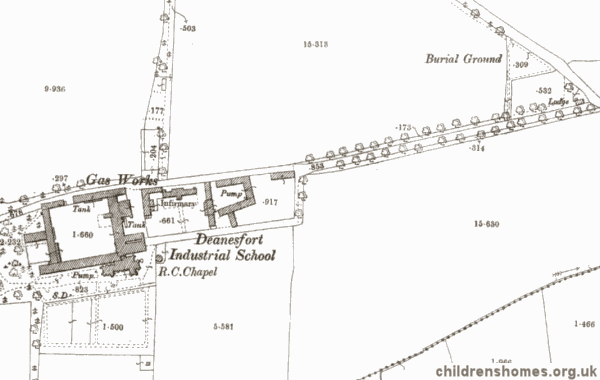St Patrick's Reformatory / Danesfort Industrial School, Upton, Co. Cork, Republic of Ireland
The Institute of Charity, also known as the Rosminians, was a religious order founded in Italy in 1828 by Antonio Rosmini-Serbati. In 1857, the Rosminians took charge of a Reformatory School for Catholic boys at Market Weighton in Yorkshire. Two years later, they were invited to run the proposed new St Patrick's Reformatory at Upton in County Cork. St Patrick's officially came into operation on November 6th, 1860, although the first boy had been received a week earlier.
The School was located on a property known as Deanesfort, to the east of Upton and north of Inishannon. A new building, designed by Richard Brask, in the shape of a square around a central courtyard, was constructed at a cost of £5,000. The institution could claim to be the only Reformatory School in Ireland which was specially built for the reception of young offenders. At the end of 1862, there were 147 inmates in residence.
Boys at St Patrick's were engaged in a variety of industrial training activities which eventually included tailoring, shoemaking, baking, painting, book-binding, carpentry, and cart and wheel making. Agricultural work featured prominently and a large number of cattle, pigs and poultry were kept. The School initially had 110 acres of land, which encompassed the Upton & Inishannon Road station on the Cork to Bandon railway line. This provided a useful means of despatching the produce of the institution's market gardening activities. Additional land was gradually acquired with the School's farmland eventually extending to 256 acres by 1880. At the same date, the average number of inmates was 245 who were under the charge of the manager, the Rev. John Hayde, assisted by a chaplain and 21 officers.
Over the next decade, however, numbers at the School steadily declined and had fallen to 117 by 1889. It was therefore decided to close St Patrick's from April 8th, 1889. The existing inmates were transferred to the large Reformatories at Glencree and Philipstown. Five days later, the Upton site re-opened as the Danesfort Industrial School, with accommodation for up to 200 Roman Catholic boys.
The Danesfort site is shown on the early 1900s map below.

Danesfort Industrial School site, Upton, c.1905.
In 1870, it was recorded that the School now had a gas manufacturing plant installed. The gas generated was used for cooking and for heating the buildings. A Turkish bath had also been installed which the School's official inspector described as a valuable sanitary adjunct, particularly for the skin diseases often found on new inmates, and which merited fitting in every similar establishment.
A large part of the building was destroyed by an accidental fire on July 21st, 1966. The School ceased operation in October of that year. Its closure was not connected with the fire but had been in the offing for some time due to falling numbers, a lack of trained staff, and the reorganisation and rationalisation of the schools run by the Order.
The premises were reopened in 1972 as a centre for adults with learning difficulties run by a different religious order, the Brothers of Charity. Ownership of the site was taken over by the state in 2003 although the Brothers of Charity continued to provide services at the establishment.
Ireland's Commission to Inquire into Child Abuse (CICA), established in 2000, heard that extensive physical and sexual abuse had taken place at Danesfort over a many years, something which was admitted by the Order. There was a regime of punishment and fear, with bed-wetting punished by humiliation and beating. A leather strap was in frequent use. The food that was provided to the boys was often poor in quality and meagre in quantity. Sexual abuse by religious and lay staff was widespread — on occasion, there were as many as four known abusers working at the School. Their activities were largely ignored or the perpetrators moved elsewhere.
Records
Note: many repositories impose a closure period of up to 100 years for records identifying individuals. Before travelling a long distance, always check that the records you want to consult will be available.
- The Rosminians Institute of Charity (Ireland), Clonturk House, Ormond Road, Drumcondra, Dublin 9.
Bibliography
- Child Abuse Commission's Report on Danesfort
- Arnold, Mavis, and Laskey, Heather Children of the Poor Clares (2004, Appletree Press)
- Barnes, Jane Irish Industrial Schools 1868-1908 (1989, Irish Academic Press)
- Dunne, Joe The Stolen Child: A Memoir (2003, Marion Books)
- Rafferty, Mary and O'Sullivan, Eoin Suffer the Little Children: The Inside Story of Ireland's Industrial Schools (1999, New Island Books)
- Touher, Patrick Fear of the Collar: Artane Industrial School — My Extraordinary Childhood (1991, O'Brien Press)
- Tyrrell, Peter and Whelan, Diarmuid Founded on Fear: Letterfrack Industrial School (2006, Irish Academic Press)
- Wall, Tom The Boy from Glin Industrial School (2015, Tom Wall)
Links
- The Rosminians Institute of Charity (Ireland)
- The Brothers of Charity
- Glencree Reconciliation Centre (former Reformatory site)
- The Commission to Inquire into Child Abuse
Except where indicated, this page () © Peter Higginbotham. Contents may not be reproduced without permission.


